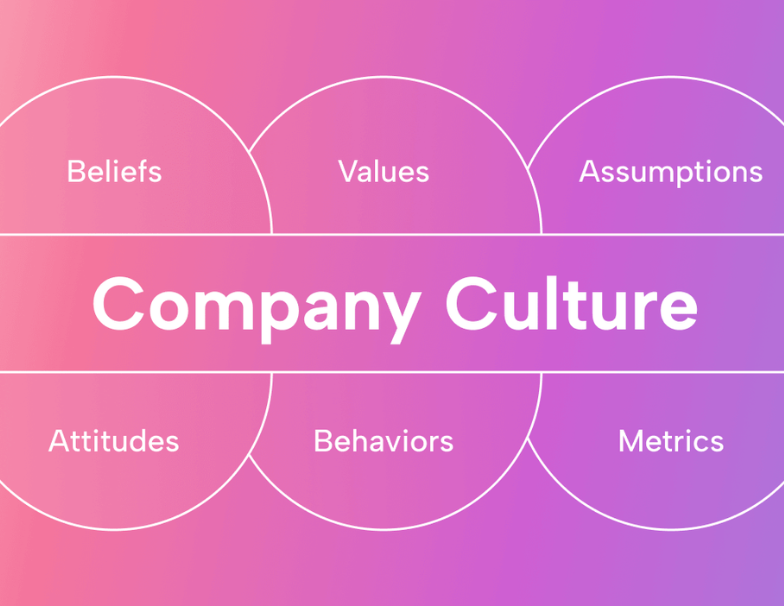6 Types of Company Culture: Identify and Transform Your Workplace Atmosphere

Looking to improve your workplace atmosphere? Understanding the types of company culture can help. This article breaks down seven distinct styles, offering insights into how each type affects employee behavior and organization success. Learn how to identify and transform your company’s culture effectively.
Key Takeaways
- Company culture significantly influences employee retention, productivity, and overall organizational success; strong cultures can lead to higher financial returns.
- Understanding the seven types of company culture—Clan, Adhocracy, Market, Hierarchy, Purpose-Driven, Enjoyment—is essential for identifying and transforming workplace environments to foster engagement and innovation.
- Transforming company culture requires clear goal alignment, active employee engagement, consistent feedback mechanisms, and a commitment to open communication to ensure a supportive and productive atmosphere.
Understanding Company Culture

Company culture is the overall environment within an organization, encompassing mission, values, work ethics, and team dynamics. It influences productivity, employee happiness, and the company’s reputation. A strong, positive workplace culture, organizational culture, corporate cultures, healthy culture, safety culture, and workplace cultures often yield higher financial returns and are vital to a company’s success, reflecting the broader culture.
Shaped by vision, mission, and leadership, company culture continuously evolves. With 92% of employees believing that organizational culture affects their decision to stay, its importance in retention cannot be overstated.
Clan Culture: Fostering a Family-Like Environment
Clan culture is characterized by:
- A people-oriented environment that emphasizes teamwork, collaboration, shared values, and a strong sense of belonging.
- A family-like environment where employees feel connected and valued.
- Often being found in small or family-owned businesses.
- Fostering a supportive work environment through open communication and teamwork.
- Leaders acting as mentors, focusing on employee development and engagement, promoting a collaborative culture and clan cultures.
The atmosphere in a clan culture is one of high employee engagement and loyalty, which significantly boosts morale. However, challenges in scalability can arise due to the close-knit nature of such cultures. Overall, the emphasis on building a strong community and collaboration among employees makes clan culture a nurturing and engaging environment.
Key Indicators of Clan Culture
Key indicators of clan culture include mentorship initiatives, team-building activities, and professional development opportunities. Collaborative workspaces and activities like team lunches and mentorship programs significantly enhance this culture, making employees feel valued and connected.
Transitioning to Clan Culture
Transitioning to a clan culture begins with:
- Engaging employees and being open to their feedback.
- Hosting community events and encouraging open dialogue as fundamental steps.
- Acting on employee feedback to ensure everyone feels heard and valued, smoothing the transition.
Adhocracy Culture: Driving Innovation and Risk-Taking

Adhocracy culture prioritizes creativity, flexibility, and the development of new products. It fosters an entrepreneurial atmosphere where innovation and risk-taking are encouraged. This culture is often found in startups and companies that value experimentation, such as Netflix. However, the dynamic nature of adhocracy cultures requires careful management to balance risks and sustainability.
The main challenge of adhocracy culture is the potential for new ventures to fail and the lack of collaboration among employees. Despite these challenges, companies with adhocracy culture emphasize a future-based approach and take calculated risks to drive innovation and business success.
Recognizing Adhocracy Culture
Adhocracy culture can be recognized by its high emphasis on creativity, innovation, and flexibility. Companies with this culture typically prioritize project-based work over traditional hierarchies, creating a dynamic and responsive work environment.
Building an Adhocracy Culture
Building an adhocracy culture involves promoting a mindset of continuous learning organizational culture and adaptability among teams. Methods include:
- Strategy sessions
- Brainstorming
- Sharing ideas
- Rewarding successful innovations.
Fostering this culture involves encouraging experimentation and providing constant innovation resources.
Market Culture: Competing for Success

Market culture is characterized by:
- A strong focus on external competition and profitability.
- The primary goal of growth and winning in the marketplace, often encapsulated by the motto, “We’re in it to win it.”
- Companies like Amazon and Tesla exemplify market culture through their competitive strategies.
- Decisions made based on their financial performance impact, driving a results-oriented environment, reflecting various market cultures.
While market culture can lead to remarkable business success, it also poses risks such as employee burnout and lack of engagement due to excessive competitiveness. Despite these challenges, this culture fosters a high-performance atmosphere that can drive significant company success.
Traits of Market Culture
Traits of market culture include:
- Performance-based incentives
- A focus on competitiveness and profitability
- Prioritization of external performance metrics
- Ensuring that the company maintains a competitive edge in the market.
Shifting to Market Culture
Shifting to a market culture requires:
- Establishing clear financial targets
- Aligning business strategies with these goals
- Setting performance-based incentives to motivate employees to achieve these targets, fostering a competitive and results-oriented environment.
Hierarchy Culture: Emphasizing Structure and Stability

Hierarchy culture is characterized by:
- Many layers of management
- Strict adherence to rules
- Established procedures
- Emphasis on stability, reliability, and maintaining established protocols in hierarchy cultures.
Examples of such companies with this culture include IBM, McDonald’s, and HSBC, which operate with a structured, top-down hierarchy that ensures clear operational responsibilities and strategic objectives, reflecting various types of organizational structures and a traditional corporate structure.
Promotions are typically handled from the bottom up based on established rules and procedures.
While hierarchy culture ensures stability and reliability, it can also lead to a focus on personal gain over organizational success. Employees often adhere strictly to rules and established norms such as dress codes and rigid work hours. This authority culture is ideal for a particular organization that prioritizes order organizational culture and methodical approaches to their operations, reflecting the dominant culture within the workplace and the resulting organizational culture.
Signs of Hierarchy Culture
Signs of hierarchy culture include multiple management layers, strict adherence to rules, and methodical processes influenced by more than one culture. Employees in this culture typically focus on fitting into the organizational structure and adhering to established procedures.
Adopting Hierarchy Culture
Adopting a hierarchy culture involves defining clear processes and filling any gaps in the chain of command to improve organizational culture. Clear long- and short-term goals for every team and department are vital for a successful transition.
Purpose-Driven Culture: Aligning with Mission and Values

Purpose-driven culture is defined by a strong mission or cause aligned with company and employee values. The focus is on sustainability and community impact, going beyond just profit. Companies like Patagonia and TOMS exemplify this culture by creating products with minimal harm and supporting good causes. These organizations align employee goals with the company’s mission by integrating their strategies and operations with their core purpose culture.
A purpose-driven culture not only enhances employee engagement but also drives long-term sustainability and societal impact. Aligning corporate goals with compassion and global impact enhances overall success, making this caring organizational culture ideal for organizations looking to make a positive difference in the world.
Indicators of Purpose-Driven Culture
Indicators of purpose-driven culture include a focus on long-term sustainability and societal impact. Employees’ well-being is strongly correlated with profitability and sustainability, making it a key characteristic of such cultures.
Cultivating Purpose-Driven Culture
Cultivating a purpose-driven culture involves:
- Focusing on group achievements instead of individual accomplishments.
- Encouraging innovation, experimentation, and idea sharing.
- Fostering a learning culture within the organization.
Supporting this culture requires investment in R&D and providing resources for employees.
Enjoyment Culture: Creating a Fun Work Environment
Enjoyment culture is characterized by:
- A fun approach to work
- Playful workspaces
- Flexible hours
- Informal dress codes
- Colorful environments
- Games
- Good food
- Enjoyment organizational culture
Companies like Google exemplify this culture, where acquiring and nurturing the right talent leads to employee loyalty and motivation. Happiness in an enjoyment culture has been shown to increase productivity among happy employees, revealing the effectiveness of such environments and contributing to a positive employee experience and positive company culture.
This culture values independence and flexibility, ensuring that all employees attend the same training regardless of their position. Creating a positive workplace culture and engaging work environment hinges on prioritizing employee happiness and fostering a playful atmosphere.
Recognizing Enjoyment Culture
Recognizing enjoyment culture involves looking for:
- Informal communication
- Fun activities
- A balance between freedom and accountability
- Promotions based on performance, rather than office politics
Developing Enjoyment Culture
Developing an enjoyment culture requires a budget for activities, team-building games, and encouraging informal communication. Balancing freedom with accountability ensures that employees thrive while fulfilling their responsibilities.
How to Evaluate Your Company’s Culture
Evaluating your company’s culture involves identifying goals, engaging employees, and aligning culture with business strategy. Regularly reviewing and updating policies ensures alignment between culture and goals.
Assessing leadership practices and their impact on collaboration, innovation, and employee well-being is also crucial.
Conducting a Culture Audit
Conducting a culture audit involves assessing values, behaviors, and practices to identify the existing culture. Reviewing mission statements, core values, and company policies is the first step. Observing workplace interactions, such as communication and conflict resolution, provides insights into the company culture.
Collecting employee feedback through surveys, focus groups, and interviews is vital.
Gathering Employee Feedback
Gathering employee feedback can be done through surveys, focus groups, and interviews. Regular feedback mechanisms encourage employees to feel valued and promote open dialogue about cultural changes.
Transparent communication and regularly scheduled surveys provide ongoing insights into employee sentiment.
Best Practices for Transforming Company Culture
Transforming company culture involves:
- Defining and assessing current culture
- Setting financial goals
- Aligning with the company’s mission and core values
- Engaging employees through recognition programs
- Celebrating those who exemplify company values to enhance the overall culture.
Tracking progress requires conducting a culture audit and collecting feedback and performance data.
Defining Core Values
Aligning employee actions with the company’s mission and vision starts with defining core values and the company’s values. These values should be authentic and resonate with employees to ensure they are actionable and relatable.
Effective core values create a competing values framework for behavior and decision-making, fostering collaboration and nurturing a purpose-driven culture.
Encouraging Open Communication
Building trust, improving employee satisfaction, and enhancing engagement all stem from encouraging open communication. Practices such as open-door policies, top-down communication, and meeting hours for employee-leadership connections are crucial. Regular check-ins and open forums enhance understanding of employee perspectives and support cultural transformation.
Transparent communication keeps employees aware of and understanding organizational culture changes, fostering a productive, engaging work environment.
Summary
Understanding and transforming company culture is crucial for fostering a productive and positive work environment. By recognizing and implementing the various types of company culture—clan, adhocracy, market, hierarchy, purpose-driven, and enjoyment—you can align your workplace with your company’s mission and values. Regular evaluation and open communication are key to maintaining a healthy and engaging culture where employees thrive. Embrace these insights to create a dynamic and supportive workplace atmosphere that drives organizational success.
FAQs
- What is company culture?
Company culture refers to the overall environment within an organization, which includes its mission, values, work ethics, and team dynamics. It plays a crucial role in shaping employee behavior and satisfaction.
- How can I recognize adhocracy culture in my organization?
You can recognize an adhocracy culture in your organization by observing a strong emphasis on creativity and innovation, alongside a preference for project-based work and flexible structures rather than rigid hierarchies. This dynamic environment fosters collaboration and encourages employees to take risks in pursuing new ideas.
- What are the key indicators of clan culture?
Clan culture is characterized by strong mentorship, team-building activities, opportunities for professional development, and collaborative work environments. These elements foster a sense of community and shared values within the organization.
- How can I gather employee feedback to evaluate my company's culture?
Gathering employee feedback through surveys, focus groups, and one-on-one interviews is essential for evaluating and enhancing your company's culture. This approach will yield valuable insights for making informed improvements.
You may also like
Unique spaces for your next offsite
Find distinctive venues for your upcoming corporate retreat.
Stay Updated with Our Insights
Get exclusive content and valuable updates directly to you.







